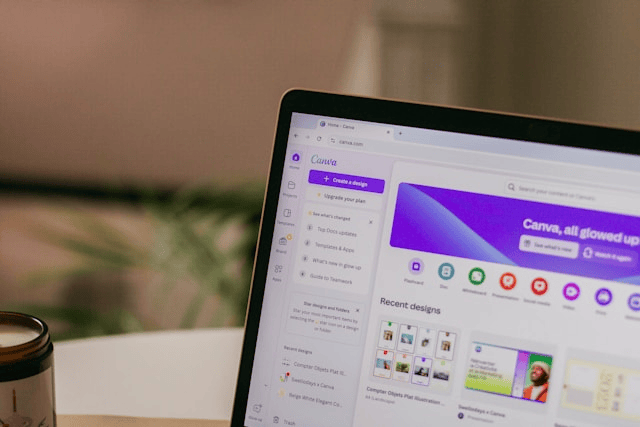In the world of online content creation, stunning visuals are key to standing out. Whether you’re a business owner, blogger, student, or just someone wanting to enhance your digital presence, knowing how to use Canva can transform your designs from basic to brilliant. Canva is an intuitive and powerful online graphic design tool that empowers anyone to create professional-quality visuals no design background required.
Let’s explore how you can use Canva to create graphics online that truly captivate.
What is Canva and Why Use It?
Canva is a free design software that simplifies graphic design for beginners and non-designers. It offers a drag-and-drop interface, an extensive library of templates, and a wide range of tools that make it easy to design anything from Instagram posts and presentations to business cards and resumes.
What sets Canva apart is its accessibility. Whether you’re designing for social media, building a brand, or working on a school project, Canva provides everything you need to get started quickly and easily.
Getting Started with Canva
To begin, head over to Canva.com and sign up with your email or Google account. Once logged in, you’ll land on your dashboard, where you can search for design types or start a custom-size project.
Here’s what you’ll see on the Canva dashboard:
-
Templates for various uses like posters, social media graphics, or YouTube thumbnails.
-
Your Projects, where all your past designs are saved.
-
Design Tools like elements, photos, text, backgrounds, and more.
Canva offers both free and Pro versions. The free version includes thousands of templates and design elements, which are sufficient for most users. Canva Pro unlocks premium assets, brand kits, and advanced tools like background remover and resizing.
Using Templates and Pre-Made Designs
One of the easiest ways to create graphics with Canva is by starting with its pre-designed templates. These templates cover everything from:
-
Instagram and Facebook posts
-
Infographics and resumes
-
Invitations and event flyers
-
Presentations and business reports
To use a template, simply type in what you need (e.g., “Instagram Story template”) into the search bar. From there, you can customize the colors, text, images, and layout to match your brand or style.
Using Canva templates saves time and provides a polished foundation for your design.
Design Basics in Canva
Canva’s drag-and-drop design editor makes it simple to personalize templates or start from scratch. Here are the basics of using Canva:
-
Text: Add headings, subheadings, or body text. You can choose from hundreds of font styles.
-
Colors: Use preset palettes or enter your brand’s HEX codes.
-
Elements: Insert shapes, lines, icons, illustrations, and more.
-
Images: Upload your own photos or choose from Canva’s free and premium image library.
-
Layers: Adjust the position of elements with front/back layering for a professional look.
Designing becomes effortless when you understand how to use Canva’s tools to bring your creative vision to life.
Creating Graphics for Different Platforms
One of Canva’s most helpful features is its built-in size presets for various platforms. When creating graphics for social media, marketing, or web content, you can select the correct size right from the start.
-
Canva for social media design: Ready-made sizes for Instagram posts, Stories, Facebook banners, Twitter headers, and more.
-
Blog and website graphics: Easily design Pinterest pins, blog banners, and website sliders.
-
Marketing materials: Create business cards, brochures, flyers, and ads with print-ready formatting.
These presets ensure your graphics look perfect wherever you post them.
Tips for Creating Stunning Visuals
Even with a great tool like Canva, knowing a few design best practices can help your visuals stand out even more:
-
Keep it simple
Don’t overcrowd your designs. Minimalism often makes a stronger impact. -
Use white space
Give your content room to breathe. White space improves readability and visual appeal. -
Choose consistent fonts and colors
Stick to two or three font styles and a consistent color palette to maintain brand identity. -
Create visual hierarchy
Use font sizes, bold text, and contrast to guide the viewer’s eye. -
Use high-quality images
Whether uploading your own or using Canva’s library, clear, high-res images are essential.
These tips, combined with Canva’s intuitive tools, can dramatically improve the quality of your content.
Saving and Exporting Your Designs
Once you’re happy with your design, it’s time to save and share it. Canva allows you to download your designs in various formats:
-
PNG: Ideal for web use and transparent backgrounds (Pro feature).
-
JPG: Great for photos and quick-loading images.
-
PDF: Perfect for printable materials.
-
MP4 or GIF: For animated or video designs.
You can also share your design directly to social platforms or collaborate with team members using Canva’s sharing links.
For business users, Canva’s Brand Kit (available in Pro) allows you to save brand fonts, colors, and logos for consistent designs across projects.
Final Thoughts
Learning how to use Canva opens the door to creating graphics that are not only visually appealing but also effective in communicating your message. Whether you’re designing for business, school, or personal use, Canva gives you the tools to stand out online without needing expensive software or design expertise.









